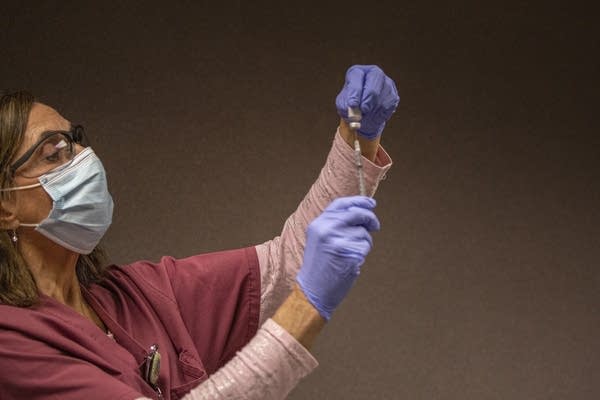Thousands of vaccine slots for older Minnesotans fill quickly, demand swamps phone lines, website

Go Deeper.
Create an account or log in to save stories.
Like this?
Thanks for liking this story! We have added it to a list of your favorite stories.
After weeks of vaccinating health care workers and nursing home residents and staff, the state of Minnesota has opened up vaccinations to anyone 65 and older to get the COVID-19 vaccine. But the rollout, billed as a pilot, was almost too popular.
Roxanne Britz had a small army — her son, daughter and son-in-law — helping on the first day.
There were around 6,000 slots available, and Minnesota has roughly a million people who fit the descriptions. The Britzes needed luck — lots of it.
“I knew it was going to be a long shot,” Roxanne Britz said. “And that's actually what did happen.”
Turn Up Your Support
MPR News helps you turn down the noise and build shared understanding. Turn up your support for this public resource and keep trusted journalism accessible to all.
Roxanne Britz and her husband, both 67, were able to land appointments. Once the state opened up the appointment process at noon Tuesday, others found a series of obstacles — busy phone lines or web pages forever refreshing or timed out.
As of 3:45 p.m., the state fielded 232,000 phone calls seeking appointments and the website for appointments, at its peak, had 10,000 unique hits per second.
”To be clear, we do not have enough vaccine for everyone who wants one,” said Kris Ehresmann, director of disease epidemiology at the Minnesota Department of Health.
”But we are working hard to build a community vaccination system so we are ready, using clinics and others, to get Minnesotans immunized once the federal government provides these doses,” Ehresmann said.
Victoria Ford and her sister used their phones and computers to try to get their parents an appointment. She said her father’s congestive heart failure made their effort more urgent.
”As soon as we can get him a vaccine, he can be safer as he goes about his life,” Ford said.
She didn’t have high hopes and knew there would be many people trying to do the same. But she thought it would be good just to get an understanding of how the system works.
They spent about an hour trying.
“We were not successful,” Ford said. “When I went to submit it, it got stuck in, you know, the circle symbol where the computer is thinking, but that doesn't ever progress.”
While Ford is happy to get the opportunity, she worried that this system was just extending economic and racial inequities.
“We both have jobs where we could put in an hour during the day to spend time doing this,” she said. “And that means that we're only going to perpetuate the inequities that have already been made clear through who's getting most harmed by COVID.”
Ehresmann said finding out who is getting the vaccine by race and ethnicity depends on providers to obtain permission and then supply the information. She did not say when health officials would have a breakdown of vaccinations by race. The state Health department’s COVID-19 website does publish case and death information by race and ethnicity.
Tarek Tomes, the commissioner of Minnesota IT services, emphasized that changes will be made to the pilot program.
“We're going to do everything that we can to take the lessons learned from this launch to continue to improve that experience. For our seniors and other people that are registering for these sites, we absolutely expect this process to be much, much smoother in the future.”
The state plans to have a similar sign up event online next Tuesday.


